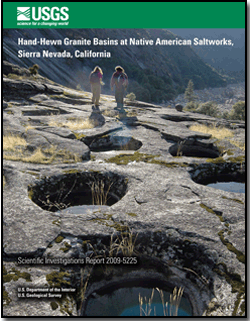Long before textiles were produced en masse or Andrew Carnegie perfected steel manufacturing, this ancient group of Native Americans was manufacturing and trading salt. New research from the USGS reveals that hundreds of man-made basins three to four feet in diameter were carved into solid granite and cover an area the size of a football field in the Sierra Nevada. These basins were filled with water from a nearby salt spring. When the water evaporated in the hot summer months, a salt residue that could be harvested was left at the bottom. They could manufacture three tons of salt each season, giving them more than enough for use within their own community and a surplus for trade.

Full report:
Hand-Hewn Granite Basins at Native American Saltworks, Sierra Nevada, California
This site in the northern Sierra Nevada contains about 369 circular basins carved in fresh, glaciated granodioritic bedrock, with 325 basins crowded together in an area of 2,700 m2 on the main terrace. These terrace basins have a median average diameter of 125 cm (80 percent between 100 and 160 cm) and a median depth of 75–80 cm. They show a strong congruity to similar granitic basins in the southern Sierra Nevada apparently of Native American origin that are generally shallower.
The basins are not of natural origin, as indicated by uniformity in size and nonoverlapping character of the basins; their common arrangement in lineaments; details of the shape of the basins; features in common with granite basins in the Southern Sierra Nevada; and, most compelling, the clustering of all the basins adjacent to (within 20 m of) two saline streams fed from a nearby salt spring. Native Americans apparently excavated them for the purpose of collecting saline water to evaporate and make salt for their use, and also as an animal attractant and a trade commodity.
The flow of the salty streams delivers about 2.9 metric tons of salt per summer season to the basin area, and evaporation rates and the holding capacity of the basins indicate that about 2.5 tons of salt could be produced per season. This correspondence shows that the Indians made enough basins to exploit the resource. The site is the most impressive prehistoric saltworks yet discovered in North America and represents a unique departure from traditional hunter-gatherer activities to that of manufacturing.
The actual grinding of so many basins in granite could not have been done without the labor of a concentrated population. It is believed that the work was accomplished over a long time by many people and with the use of fire to help disaggregate the bedrock.
No comments:
Post a Comment